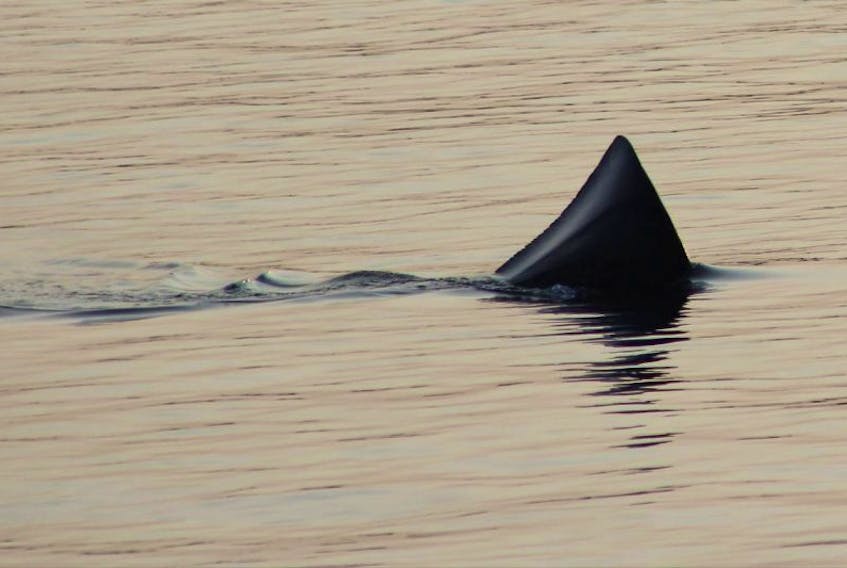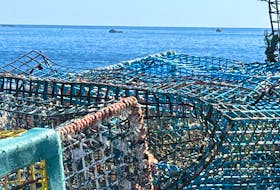Reports began pouring in this July as humpback whales and basking sharks were seen swimming in extremely shallow waters along both islands.
Sightings have continued, begging the question of why this is happening with sharks and whales at the same time.
According to the experts, the sharks’ behaviour is normal, while the whales could be cause for concern.
Normal basking shark behaviour
Warren Joyce is an aquatic science technician with the Department of Fisheries and Oceans and has confirmed the higher than usual number of basking shark sightings reported this year.
He says there is no reason to worry about the sharks’ behaviour.
Basking sharks are the largest fish in the world – second only to the fellow filter-feeding whale shark – reaching between 20 and 30 feet at full size.
They normally swim in waters 200 to 2,000 metres deep but can be seen seeking shallower, warmer waters, according to the DFO website.
“Basking sharks are sometimes found swimming this close to shore in spring and summer months – we normally know of six sightings per year in Nova Scotia,” said Joyce.
Still, sightings higher than normal
Though he didn’t have exact numbers, Joyce confirmed sightings this year are higher than six whales.
No scientific explanation exists for this increase. Exact population numbers are also unknown, but 10,000 basking sharks are estimated to swim in Atlantic Canadian waters, according to the website.

Joyce describes the shark’s behaviour as sort of lethargic and lazy, but says this isn’t a reason to approach them without caution.
“Basking sharks are often seen with both dorsal and tail fins sticking out of the water, swimming slowly,” he said.
“They are still a very large and powerful animal and could cause harm, though they’d never intentionally attack a human.”
Reports of distressed and dying basking sharks are also common, due to their inshore swims – six alone were reported last year in the Bay of Fundy.
The department recently created a hotline, email and Twitter account for shark sightings in response to increasing reports.
To report a shark sighting in the Maritime region, contact the DFO Shark Sighting Hotline at 1-844-400-7870, email at [email protected] or tweet at @dfo_mar.
Watching whales’ whereabouts
Marine researcher and Freeport resident Carl Haycock first moved to Brier Island in 1986, and has been working there as a naturalist ever since.
His research focus is humpback whales. As someone who helped found the Brier Island whale watching industry, Haycock knows a thing or two about normal whale behaviour in the area.
“We have definitely seen huge amounts of whales this year out on the boats, but also in shallow waters,” he said.
“While it’s great to see them out there, seeing them this close to shore is concerning.”
The sightings have been reported on the Bay of Fundy side of both brier Island and Long Island.

Haycock confirmed most sightings have been humpback whales, along with small numbers of fin whales, mink whales and right whales.
Making an educated guess
Haycock has several hypotheses to explain why whales would be swimming so close to shore.
His biggest is food scarcity.
“The whales that come inshore look like they’re foraging,” he said.
“We’ve also seen whales – adults and calves alike – looking thin this year.”
He likens the situation to what is causing right whales to swim up the Gulf of St. Lawrence in search of food, as reported by the Chronicle Herald.
Humpback whales feed on herring, which feed on copepods, a small species of plankton. Right whales also feed on this small species, according to Haycock.
He worries the amount of both herring and copepods in the islands’ waters may not be enough to maintain this essential balance.
“There’s been enough herring and plankton to sustain the whale watching industry, but we still notice them moving around a lot,” he said.
“These whales eat more than a tonne of herring a day. We have to ensure work is done to keep numbers where they ought to be.”
To report a regular whale sighting to DFO, call 1-844-800-8568 or email [email protected].
To report entangled, injured or dead whales, please contact the Marine Animal Response Society as soon as possible at 1-866-567-6277 or VHF Channel 16 or email [email protected].
See also: Right whale spotted entangled in fishing gear off Quebec’s Gaspe Peninsula
U.S. launches investigation into North Atlantic right whale deaths
Big mammals, big problems: Why are so many right whales dying?
Thirteenth right whale found dead
Accidental deaths of endangered whale threatens its survival
Right whale deaths: Ottawa orders ships to slow down in the Gulf of St. Lawrence









